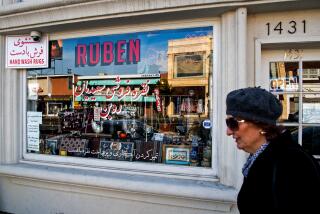The Fast Track : Lowrider Magazineâs Popularity Is Accelerating
It takes Alberto Lopez two words to explain the increasing success of the publishing empire heâs built around lowrider cars: âTheyâre cool.â
Nine-million-dollars cool, in fact.
That is the amount Park Avenue Publishing, parent company of Lowrider magazine, Lowrider Arte, Lowrider Bicycle and Street Beat magazine grossed last year, said Lopez, Park Avenueâs owner and publisher.
Yes, the numbers pale compared to giants such as Time Warner Inc., but they certainly raise eyebrows among those who tend to look at the lowrider as, well, lowly.
Youâve no doubt seen those coolest of wheels at some time or another, cruising down one of L.A.âs boulevards, immaculately groomed and perhaps strutting a mural-like painting on its hood or sides. And while lowriders are, by definition, cars that have been lowered, the opposite can be said about the steady growth of Lowrider magazine, Park Avenueâs flagship publication. It circulates about 200,000 copies a month, up 23% from last year, according to Lopez, whose numbers are audited by the Audit Bureau of Circulation.
âThe whole evolution of what weâve done with the magazine is phenomenal,â Lopez says. âWe had very humble beginnings and it just really caught on. Itâs not a high-echelon title like Hispanic Magazine or Hispanic Business, and I think thatâs why people embrace it, because itâs a grass-roots publication.â
Lowrider magazine seeks to promote Chicano culture and revolves around âthe automobile and the pretty ladies--they go hand in hand,â says Lopez, 43. He owns six cars, three of them lowriders, but drives a red Ferrari to work.
Since 1987, Lowrider and its spin-off publications have grown steadily, not only in Los Angeles--the heart of lowrider culture--but also in the Midwest, the East Coast and in markets as far-flung as Japan and Australia.
The magazine caters primarily to young Latino males, but Lopez says his readers encompass the full spectrum of the income scale. And 20% of buyers are non-Latino whites. The roughly 150 advertisers per issue tend to be auto parts manufacturers or others who can sell to those interested in lowriders, including rap and hip-hop record labels and even chewing tobacco.
Dressed for business at his Pomona office, Lopez at first seems far removed from the cruisers that have permeated public consciousness through MTV videos and East L.A. movies, and far from the women who grace the covers of Lowrider magazine in skimpy attire.
But as he speaks, it becomes apparent that he has his finger on the pulse of his target audience.
A third generation Mexican American, Lopez was born in San Angelo, Tex., but moved with his family to California when he was 12 years old.
Admittedly never a brilliant student, he went to Ohlone College in Fremont for two years, earning an associate of arts degree in marketing. He took a Chicano studies class, which helped him define his identity, and made a video on lowriders as a communications class project.
It was enough to get him hooked. A few years later, while handling public relations at a music festival in San Antonio in 1979, he met the original Lowrider magazine publisher, Mario Madrid, and landed a job with the publication.
âIâve always seen lowriders as a work of art because the creativity that goes into them is phenomenal,â Lopez says. âAnd when I saw the publisher in San Antonio, I said, âMan this is a great idea.â I could see the vision that he had.â
Lopez was hired as the first marketing and advertising director for the fledgling publication, which was based in San Jose.
But three years later, he left, because of a âcreative conflictâ with Madrid and started his own advertising company. In 1985, Lowrider magazine went bankrupt and Lopez bought it, revamped it and had it back on newsstands by 1987. The almost instant success of the magazine surprised him.
âWe never really visualized growing to that extent,â Lopez says. âWe thought the magazine had great potential because of the audience and the growth of the Hispanic market. We thought there was a tremendous vacuum, and that lowriders and automobiles could penetrate that market and be successful. But our goal was to have 50,000 in monthly [circulation]. We surpassed that on the first year.â
The numbers donât surprise Drew Hardin, editor of Hot Rod Magazine, who sees Lowrider as one of the hot publications in the market.
âLowrider targeted a very specific vehicle and audience and that to me represents the future of automotive magazines in general,â says Hardin, whose broad-appeal Hot Rod circulates about 800,000 copies a month. â[Lowriderâs] high numbers donât surprise me because Iâve lived in California for a long time and there are a lot of people devoted to this type of vehicle. And itâs a car and a lifestyle publication.â
Aside from straight-ahead automotive features and photos, Lowrider has regular sections that deal specifically with Latino issues and the community. Lopez has also established a scholarship fund that last year doled out $35,000 to Latino college students.
âLowriding almost had a connotation of being gang-related, which is one of the furthest things from the truth,â Lopez says. âWe wanted to produce a magazine that really reflected the true heart of lowriding and its being a positive element of the community. And I think people related to that.â
One of the magazineâs big promotional tools, in fact, is the Lowrider Tour, which started with five shows in 1989 and has expanded to 16 this year. A joint venture between Lopez and partner Lorenzo Gonzalez, the event has become so popular that it now boasts stops in Japan and Hawaii. The annual Lowrider Supershow, held earlier this month in Los Angeles, drew 46,000 people.
âOur car shows are modern day fiestas,â Lopez says. âWhen we were growing up we would go to the bailes [dances] and today the car shows are becoming the nucleus for people to socialize. Yes, we have the beautiful cars and the music, but I would say 40% of the reason people go is to socialize.â
Lopez has an even simpler reason for the continued appeal of lowriding.
âIf you look at the history of lowriding, the main reason guys even started fixing their cars in such elaborate extremes was to impress the ladies. . . . You see that today. The guys with the hottest cars have the hottest ladies.â
Lopez said his only partner in Park Avenue Publishing is his wife, Dina, who is business manager. Lowriding, in fact, has become a family affair for Lopez, whose 16-year-old son, Francisco, owns a lowrider bicycle.
âI see no end to our growth,â Lopez says. âI honestly think weâll hit half a million sales in the next two to three years because [lowriding] has left the Mexican American community and crossed over and everybodyâs loving it. Itâs a crack-up, you know, when you go to Japan and you see these guys with Mexican flags draped over their cars. And when you go to Kentucky and you see a white boy hopping his car with a big sombrero. And I think itâs a credit that they love the Chicano flavor of it.â
(BEGIN TEXT OF INFOBOX / INFOGRAPHIC)
Riding a Little Higher
Lowriding is Americaâs fastest-growing custom car trend, supporting an array of automotive aftermarket companies and involving 75,000 to 100,000 vehicles nationwide. Enjoyed predominantly by young Latino men, lowriding has also gone global. Lowriding aficionados in Japan mimic the Chicano style, right down to displaying the Mexican flag in the window. A brief history:
Barrio beginnings: Lowriders originated in the barrios of East L.A. and San Jose during the late 1940s. Post World War II economic growth allowed many Latinos to find jobs in the defense and automotive industries, and to own homes and cars for the first time. Cars evolved into status symbols for Chicanos of that era, going for a drive downtown after church became a ritual.
La bomba: Typically, the first lowriders or bombas, were Chevrolets and Fords with several front suspension springs and rears lowered so much that the bumpers rested just above the ground. Less committed enthusiasts--âweekend lowridersâ--loaded the trunks of their cars with bags of cement.
Getting air: Beginning in the early 1960s, lowriders added elaborate hydraulic suspensions to their repertoires. Multiple supplemental batteries and a pair of hydraulic pumps, usually configured from airplane landing gear components and other World War II government surplus, replaced the carâs front and rear shock absorbers.
Dancing and hopping: Advancements in lowrider hydraulic technology introduced the more famous lowrider phenomena: âcar dancing,â moving a vehicle up and down and side to side in rhythm to music, and âcar hopping,â bouncing the car up in the air as high as possible. Drivers prize the 1962 â64 Chevy Impala for its superior hydraulic and aesthetic qualities.
From cars to trucks: Relatively low-prized light-body trucks caught the attention of lowrider enthusiasts in the mid-1980s, spurring another lowrider revolution. Younger drivers abandoned the classic sedans and muscle cars for fat-fendered, load-hauling mini pickups. Initially, customizers limited the alterations to gleaming wheel rims and lowered suspensions.
All the fixings: Additional innovations include multicolored metal flake paint, airbrushed murals, velour upholstery, extensive chroming and gold plating heavy-duty sound systems, and neon lighting on the undercarriages, which began in Miamiâs Cuban neighborhoods. Extravagantly adorned show vehicles are usually confined to garages until show time, the $100,000-plus cars and trucks are common targets of the police and carjackers.
Better handling: Technically, cars and trucks lacking shock absorbers and or suspension springs are in violation of California vehicle code safety requirements. However, lowrider aficionados say the hydraulic equipment actually provides better, safer handling than conventional shocks.
Lowrider bicycles: Teenagers too young for lowrider vehicles have turned to lowrider bicycles. From a 1960s Schwinn-styled frame, the bike is cut and welded so that the pedals scarcely clear the sidewalk and the raked ape-hanger handlebars scream attitude. Hard-core customizers weld flat steel into the gaps between the bikeâs frame tubes, grind off the rough edges and smooth the new lines with a popular car-repair putty, a process called âbonding.â
Sources: Lowrider magazine, Times and wire reports. Researched by DAVID NEUMAN and JENNIFER OLDHAM, Los Angeles Times
More to Read
Sign up for Essential California
The most important California stories and recommendations in your inbox every morning.
You may occasionally receive promotional content from the Los Angeles Times.









